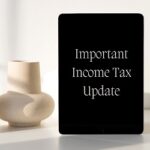Introduction
The taxation landscape is a complex and ever-evolving domain, and one crucial aspect that taxpayers need to navigate is the tax audit. Under the Indian Income-tax Act, taxpayers are required to maintain proper books of accounts and undergo a tax audit if their gross turnover or receipts during the previous year exceed the prescribed threshold limit. This obligation is outlined in Section 44AA (books of accounts) and Section 44AB (tax audit) of the Income-tax Act. The primary purpose of a tax audit is to ensure that taxpayers maintain accurate books of accounts and adhere to the provisions of the Income-tax Act.
To facilitate this process, taxpayers are required to furnish a tax audit report electronically via the e-filing portal. This report takes the form of Form No. 3CA/3CB-3CD, and its completion is an essential part of the tax audit process.
In this comprehensive guide, we will delve into the intricacies of the tax audit report, specifically focusing on Form 3CD, which contains a detailed statement of particulars required under Section 44AB of the Income-tax Act. We will break down the reporting requirements for each clause to provide taxpayers and tax professionals with a clear understanding of what needs to be reported in their tax audit.
Form 3CD: The Statement of Particulars
Form No. 3CD serves as a structured template for tax auditors to report various details about the taxpayer’s financial activities and tax compliance. Here, we will discuss each clause of Form 3CD and elaborate on the information that needs to be provided.
1. Clause 1: Assessee’s Name
- The tax auditor is required to state the name of the assessee, providing clear identification.
2. Clause 2: Assessee’s Address
- In this clause, the tax auditor should provide the address of the assessee for proper documentation.
3. Clause 3: PAN or Aadhaar Number
- The tax auditor must include the Permanent Account Number (PAN) or Aadhaar Number of the assessee for identification purposes.
4. Clause 4: Indirect Tax Liability
- The tax auditor should report whether the assessee is liable to pay indirect taxes such as excise duty, service tax, sales tax, goods and services tax (GST), customs duty, etc.
- If applicable, the registration number or GST number, or any other identification number allotted for these taxes should be furnished.
5. Clause 5: Assessee’s Status
- In this clause, the tax auditor is required to state the “status” of the assessee, which aligns with the definition of ‘person’ in Section 2(31) of the Act.
- Status can be categorized as individual, Hindu Undivided Family (HUF), firm, Limited Liability Partnership (LLP), company, trust, Association of Persons (AOP), Body of Individuals (BOI), Local Authority, Artificial Juridical Person, Co-operative Society, or Co-operative Bank.
6. Clause 6: Previous Year
- The tax auditor should specify the previous year for which the audit is being conducted.
7. Clause 7: Assessment Year
- This clause requires the tax auditor to state the assessment year corresponding to the previous year under consideration.
8. Clause 8: Section 44AB Applicability
- The tax auditor should indicate the relevant clause of Section 44AB under which the audit has been conducted.
9. Clause 8A: Taxation Regime
- In this clause, the tax auditor is required to specify whether the assessee has opted for taxation under Section 115BA, 115BAA, 115BAB, 115BAC, or 115BAD.
10. Clause 9: Specific to Firms, LLPs, AOPs, and BOIs – Clause 9(a): Names of partners/members of firm/LLP/AOP/BOI and their Profit Sharing Ratio. – Clause 9(b): Changes in partners/members or their Profit Sharing Ratio.
11. Clause 10: Nature of Business or Profession – Clause 10(a): Description of the nature of the business or profession. – Clause 10(b): Applicable if there is an addition of a new line of business/profession or discontinuance of any business/profession during the previous year.
12. Clause 11: Books of Account and Relevant Documents – Clause 11(a): Names of assessees for whom books of account have been prescribed under Section 44AA. – Clause 11(b): List of books of account maintained and their respective locations. – Clause 11(c): List of books of account and nature of relevant documents examined.
13. Clause 12: Profit and Loss Account Items – Clause 12(a): Whether the profit and loss account includes any profits and gains assessable on a presumptive basis under specific sections of the Income-tax Act. – If yes, details of the amount and the relevant section of the Income-tax Act must be provided.
14. Clause 13: Accounting Method – Clause 13(a): Method of accounting employed in the previous year. – Clause 13(b): Whether there has been any change in the method of accounting compared to the immediately preceding previous year. – Clause 13(c): If there was a change, details of the change and its impact on profit or loss. – Clause 13(d): Whether any adjustment is required for compliance with income computation and disclosure standards notified under Section 145(2). – Clause 13(e): If adjustments are needed, provide details.
15. Clause 14: Valuation of Closing Stock – Clause 14(a): Method of valuation of closing stock in the previous year. – Clause 14(b): Applicable if there is a deviation from the prescribed valuation method under Section 145A and its impact on profit or loss.
16. Clause 15: Capital Assets Converted to Stock-in-Trade – Details of capital assets converted into stock-in-trade must be reported, including description, date of acquisition, cost of acquisition, and amount.
17. Clause 16: Uncredited Items – Clause 16(a): Report items falling under the scope of Section 28 not credited to the profit and loss account. – Clause 16(b): Refunds, proforma credits, and drawbacks of various indirect taxes. – Clause 16(c): Escalation claims not credited to the profit and loss account. – Clause 16(d): Any other income not credited to the profit and loss account. – Clause 16(e): Capital receipts not credited to the profit and loss account.
18. Clause 17: Transfer of Land or Building – Report details of transfers of land or building, regardless of whether they are held as capital assets or stock in trade, if: – The consideration received is less than the stamp duty value. – The transfer occurs during the previous year.
19. Clause 18: Depreciation Particulars – Provide details of depreciation allowable as per the Income-tax Act for each asset or block of assets. – Include descriptions, depreciation rates, actual costs or written-down values, and any adjustments.
20. Clause 19: MAT and AMT Applicability – Indicate whether the Minimum Alternate Tax (MAT) or Alternate Minimum Tax (AMT) provisions under Section 115JB or Section 115JC apply. – Provide details of computation.
21. Clause 20: Tax on Presumptive Income – If the taxpayer opts for taxation under presumptive income schemes, provide details of income computed and tax payable under these schemes.
22. Clause 21: TDS and TCS – Clause 21(a): Report whether TDS and TCS provisions under Chapter XVII-B and XVII-BB have been complied with. – If not, provide details of defaults, interest, and penalties. – Clause 21(b): Details of TDS or TCS certificates. – Clause 21(c): Details of TDS/TCS credits and advances received.
23. Clause 22: Income Tax Payment and Advance Tax – Clause 22(a): Provide details of income tax paid during the previous year. – Clause 22(b): Report advance tax paid and its installments.
24. Clause 23: Refund Claim – Report any refund claims filed and their status.
25. Clause 24: Self-assessment Tax – Provide details of self-assessment tax paid.
26. Clause 25: Audit Information – Clause 25(a): Report whether the taxpayer is liable to pay tax in any country outside India and details thereof. – Clause 25(b): Any other audit-related information required.
27. Clause 26: Principal Officer Details – Provide details of the Principal Officer under Section 2(35) of the Income-tax Act.
28. Clause 27: Section 44AE, 44BB, 44BBB Applicability – Indicate whether the provisions of Section 44AE, 44BB, or 44BBB are applicable, and provide relevant details.
29. Clause 28: Tonnage Tax Applicability – Indicate whether the taxpayer has opted for tonnage tax provisions under Section 115VJ.
30. Clause 29: Explanation of Certain Terms – Provide explanations for various terms used in Form 3CD, including unexplained expenditure, unexplained investments, etc.
31. Clause 30: Verification – The tax auditor must certify the correctness of the particulars in Form 3CD. – The taxpayer should also verify the information and sign the form.
Conclusion
A tax audit is a critical aspect of ensuring tax compliance and accurate financial reporting. Properly filling out Form 3CD, including all the required details in each clause, is essential for a successful tax audit. Failure to comply with these reporting requirements can lead to penalties and legal consequences. Therefore, it is crucial for taxpayers and tax professionals to understand and adhere to the prescribed guidelines when preparing and submitting the tax audit report.
It is advisable to consult with a qualified tax professional or chartered accountant when preparing and filing Form 3CD to ensure that all reporting requirements are met and that the audit process proceeds smoothly. Tax laws and regulations are subject to change, so staying updated with the latest amendments and notifications is also essential to maintain tax compliance.
Please note that this guide is for informational purposes only and does not constitute legal or professional advice. Taxpayers are encouraged to consult with tax professionals or authorities for specific guidance related to their individual tax situations.






